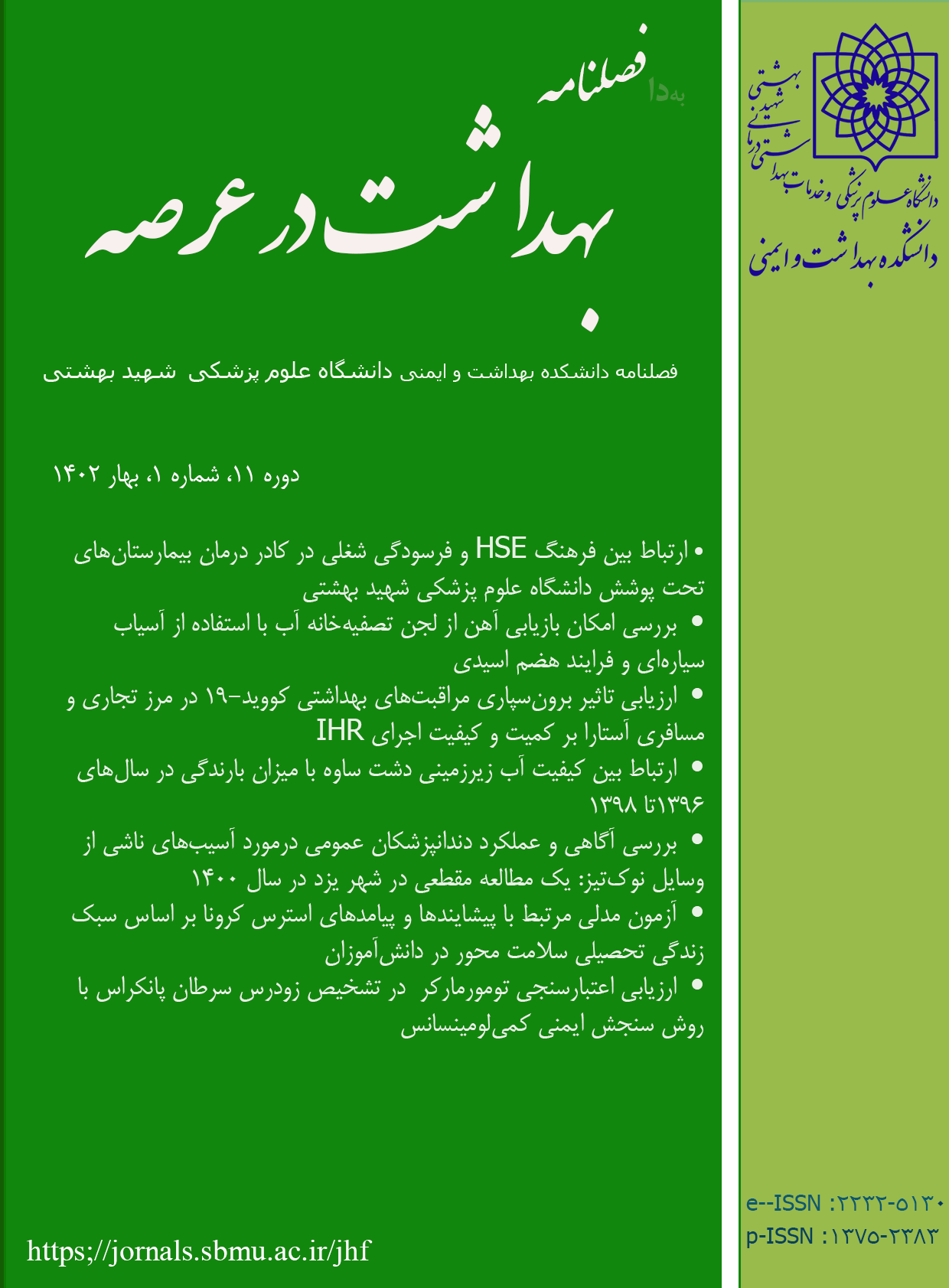تحليل روند تغييرات غلظت پنج آلاينده شاخص كيفيت هوا
فصلنامه علمی پژوهشی بهداشت در عرصه,
دوره 3 شماره 2,
21 خرداد 2015
,
صفحه 17-26
https://doi.org/10.22037/jhf.v3i2.8841
چکیده
زمينه و هدف: آلودگي هوا، تهديدي جدي براي سلامت عمومي و محيط زيست است. جهت كاهش اثرات ناشي از آلودگي هوا بايد پارامترهاي موثر در آلودگي هوا را به خوبي بشناسيم، از جمله پارامترهاي مهم در تعيين ميزان آلودگي هوا دادههاي هواشناسي است. هدف از اين تحقيق، مطالعه بررسي روند تغييرات پنج آلاينده شاخص آلودگي هوا و ارتباط آن با دادههاي هواشناسي در تهران طي سالهاي 88-1380 است.
مواد و روشها: اين مطالعه از نوع توصيفي تحليلي است. دادهها از ايستگاه سينوپتيك سازمان هواشناسي و ايستگاههاي شركت کنترل کيفيت هواي شهرداري و سازمان حفاظت محيط زيست گردآوري شده و چگونگي روند تغييرات غلظت آلايندهها و دادههاي هواشناسي و ارتباط آنها با نرم افزار آماريSPSS مورد تحليل قرارگرفت.
يافتهها: در اين مطالعه مشخص شد که در طي سالهاي مورد مطالعه بر مقادير غلظت آلاينده O3 افزوده شده و ميتوان آلاينده مذکور را آلاينده مسئول افزايش شاخص استاندارد آلودگي هوا در طي سالهاي اخير دانست. همچنين از ديگر نتايج مهم اين تحقيق ميتوان به روند کاهشي آلاينده (CO، NO2، SO2 و PM10) در طي سنوات مورد مطالعه اشاره نمود.
نتيجه گيري: طي سالهاي فوق کيفيت هواي تهران از نظر آلايندههاي CO، NO2، PM10 و SO2 بهبود يافته، در حاليكه غلظت آلاينده O3 رو به افزايش بوده و از وضعيت استاندارد فاصله داشته است. با توجه به ارتباط معني دار بين برخي از پارامترهاي هواشناسي و آلايندهها، مشخص گرديد كه متغيرهاي هواشناسي ميتوانند در ميزان آلايندگي هواي شهر تهران موثر واقع شوند.
- آلودگی هوا؛ آلاينده هاي شاخص؛داده های هواشناسی؛ تهران
ارجاع به مقاله
مراجع
Piraino F, Aina R, Palin L, Prato N, Sgorbati S, Santagostino A, et al. Air quality biomonitoring: assessment of air
pollution genotoxicity in the Province of Novara (North Italy) by using Trifolium repens L. and molecular markers.
Science of The Total Environment 2006; 372(1):350-59.
WHO. Health aspect of air pollution with particulate matter, ozone and nitrogen dioxide. Bonn, Germany: World
Health Organization; 2003 Jan.
Dominici F, Peng RD, Bell ML, Pham L, McDermott A, Zeger SL, et al. Fine particulate air pollution and
hospital admission for cardiovascular and respiratory diseases. Journal of the American Medical Association 2006
; 295(10):1127-34.
Cohen AJ, Rose Alexander H, Ostro B, Pandy KD, Kryzanowski M, Kunzail N. The global burden of disease
due to outdoor air pollution. Journal of Toxicology and Environmental Health, Part A 2005; 68(13-14):1301-307.
Lim S, Vos T, Flaxman A, Danaei G, Shibuya K, Adair-Rohani H. A comparative risk assessment of burden of
disease and injury attributable to 67 risk factors and risk factor clusters in 21 regions, 1990-2010: A systematic
analysis for the global burden of disease study 2010. Lancet 2012; 380(9859); 2224-2260.
Anttila P, Tuovinen J. Trends of primary and secondary pollutant concentrations in Finland in 1994-2007.
Atmospheric Environment 2010; 44(1):30-41.
Nadafi K, Mosavi G. Survey of air Quality in Tehran during 1997-1998. Proccedings of 3rd National Conference
on Environmental Health Engineering 2000 Oct. 10-12; Kerman, Iran. p:47-50 (In Persian).
Verma SS, Desai B. Effect of meteorological conditions on air pollution of Surat city. Journal of International
/ فصلنامه بهداشت در عرصه تحلیل روند تغ ییرات غلظت پنج آلاینده شاخص كيفيت هوا
Environmental Application & Science 2008; 3(5):358-67.
Ardakani S, Esmaeili A.Determination of the air quality in the Tehran in 2004. Proccedings of 10th National
Conference on Environmental Health Engineering 2004 Oct. 10-12; Hamedan, Iran. p:794-99 (In Persian).
US EPA. National Ambient Air Quality Standards: The Criteria Pollutants. Washington (DC): United State
Environmental Protection Agency; 1997.
DOE. National Ambient Air Quality Standards. Tehran: Departemnt of Environment, Islamic Republic of Iran.
Available from: http://www.doe.ir/Portal/home/177566. Accessed Jul 30, 2015.
DOE. National Ambient Air Quality Standards. Tehran: Departemnt of Environment, Islamic Republic of Iran.
Available at:http://www.epa.gov/air/criteria.html. Accessed Jul 30, 2015.
Hoseini E , Hashemi H , Nikravan M. Determination of the air quality in the Tehran in 2004-2007. Proccedings
of 5th National Conference on Environmental Engineering 2010 May. 4-6; Mashhad, Iran. p:1-8 (In Persian).
Baldasano J, Valera E, Jimenez P. Air quality data from large cities. Science of the Total Environment 2003;
(1):141-65.
Mamtimin B, Meixner FX. Air pollution and meteorological processes in the growing dryland city of Urumqi
(Xinjiang, China). Science of the Total Environment 2011; 409(7):1277-90.
Matyssek R, Innes J. Ozone-a risk factor for trees and forests in Europe?. Water, Air, and Soil Pollution 1999;
(1-2):199-226.
Hjellbrekke A-G, Solberg S. Ozone measurements 2000. Lillestrom: Norway; Norwegian Institute for Air
Research; 2002. Report No.: EMEP/CCC-Report 5/2002.
Shariepour, Z. Seasonal and daily variation of air pollutants and their relation to meteorological parameters.
Earth and Space Physics 2010; 35(2):119-37 (In Persian).
Jo W-K, Park J-H. Characteristics of roadside air pollution in Korean metropolitan city (Daegu) over last 5 to
years: Temporal variations, standard exceedances, and dependence on meteorological conditions. Chemosphere
; 59(11):1557-73.
Gratani L, Varone L. Daily and seasonal variation of CO2 in the city of Rome in relationship with the traffic
volume. Atmospheric Environment 2005; 39(14):2619-24.
Wise EK, Comrie AC. Meteorologically adjusted urban air quality trends in the Southwestern United States.
Atmospheric Environment 2005; 39(16):2969-80.
Christian R, Jariwala ND, Gohil DB. Summer episode temperature inversion and its impact on CO concentration
in urban environment. Proceeding of 2nd International Conference on Chemical, Biological and Environmental
Engineering (ICBEE); 2010 Nov. 2-4. Cario, Egypt. p. 327 - 30.
Elminir HK. Dependence of urban air pollutants on meteorology. Science of the Total Environment 2005;
(1):225-37.
- چکیده مشاهده شده: 876 بار
- PDF دانلود شده: 7963 بار
